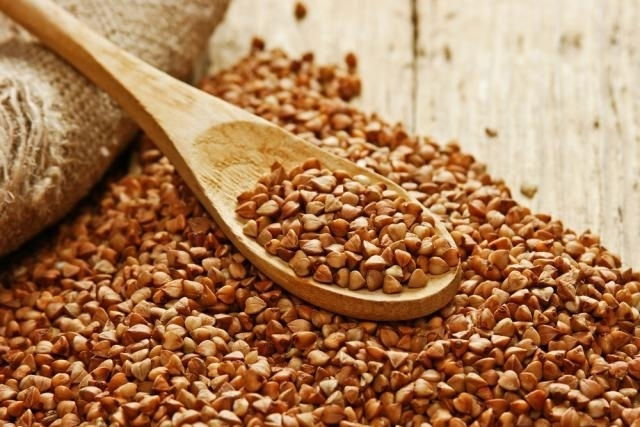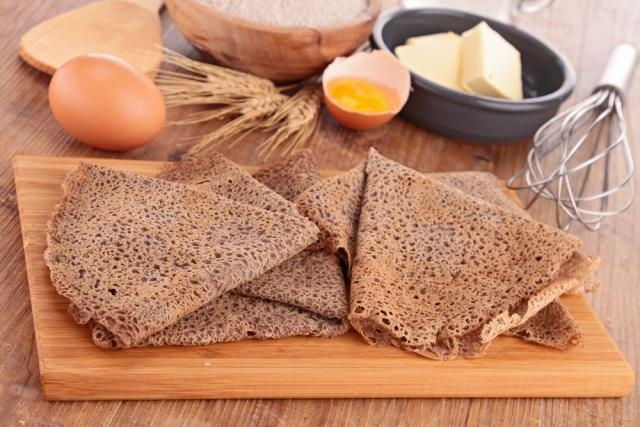Buckwheat is actually a seed, not a grain like common wheat. This seed has a very hard shell and is pink to brown in color. It does not contain gluten, and can therefore be consumed by people who have celiac disease or a gluten sensitivity.
Due to its rich nutrient content, buckwheat can also be used to replace rice or to increase the nutritional value of salads and soups.
Buckwheat can be purchased in its natural form or in the form of fine flour. It can be used to replace white flour in recipes for cake and bread.

Health benefits
The main health benefits of buckwheat are:
1. Reducing cholesterol levels
Some studies have shown that the protein present in buckwheat helps to reduce total cholesterol and LDL cholesterol levels. It also reduces the concentration of hepatic cholesterol, as it plays a role in regulating liver cell activity.
Furthermore, buckwheat reduces the absorption of cholesterol in the gut and promotes its elimination, which can help to prevent the development of cardiovascular diseases.
2. Lowering blood pressure
Buckwheat helps reduce blood pressure due to the amount of polyphenols, like rutin and quercetin, in its composition. These contribute to the regulation of the renin-angiotensin system which is responsible for controlling blood pressure.
Buckwheat is also though to stimulate the production of endogenous vasodilating substances such as bradykinin and nitric oxide, which can also promote a lower blood pressure.
3. Providing an antioxidant effect
Due to the amount of flavonoids naturally found in its composition, such as orientin, vitexin, rutin and quercetin, buckwheat can exert an antioxidant effect. It can neutralize free radicals that cause damage to cells, reducing the appearance of cardiovascular and neurodegenerative diseases as well as the formation of tumors and early-onset aging.
4. Lowering blood sugar levels
Buckwheat contains quercetin and rutin, which decrease insulin resistance. They work by increasing the activity of liver antioxidant enzymes.
Furthermore, this seed contains important amounts of D-chiro-inositol, a substance that can be used by diabetic patients to regulate insulin. Buckwheat is also digested slowly due to the presence of polyphenols, which can help to regulate blood glucose levels.
Buckwheat also has resistant starch, giving it a low glycemic index. This is beneficial for regulating blood sugar, obesity and the development of heart disease and diabetes.
5. Providing a neuroprotective effect
Buckwheat can help to prevent neurological diseases, like Alzheimer's, as it inhibits the release of glutamate. This is a neurotransmitter that can accumulate in the brain and lead to neuron degeneration.
It also prevents the death of cells in the hippocampus, an area of the brain responsible for memory. Its high tryptophan content can help to regulate mood and prevent depression.
6. Strengthening the muscles
Because it contains several essential amino acids, such as lysine and arginine, buckwheat can promote muscle health, growth, formation and recovery.
7. Improving intestinal flow
Buckwheat is a high-fiber food, which can help to regulate bowel movements and hydrate the stool. Therefore it can be consumed to prevent constipation and prevent gut infections.
Furthermore, when buckwheat is consumed in its fermented form, it also acts as a probiotic that can keep the intestinal flora and the body's pH within normal limits.
8. Reducing gas and indigestion
Because it does not contain gluten, buckwheat can help reduce gas and symptoms of indigestion. It can also prevent other digestive disorders, such as irritable bowel syndrome.
Therefore, eating buckwheat can also be considered safe for people with celiac disease or gluten sensitivity.
Also recommended: 18 Most Common Gluten Intolerance Symptoms (w/ Online Quiz) tuasaude.com/en/gluten-intolernace-symptoms9. Maintaining bone and dental health
The manganese and magnesium that is naturally present in buckwheat can promote bone health, as it can stimulate the synthesis of enzymes essential for bone formation and maintenance. It also stimulates the absorption of calcium in the gut.
The magnesium in this seed can also contribute to tooth health.
10. Providing vitamins and minerals
Buckwheat is a great source of B vitamins and minerals such as manganese, zinc, magnesium, phosphorus and iron. These can promote blood circulation, blood vessel health, muscle growth and digestion, as well as helping prevent anxiety, depression and headaches.
Nutritional information
The following table outlines the nutritional information for 100 g of whole buckwheat and buckwheat flour:
Buckwheat can be used to replace wheat flour or other grains like rice and oats. It can be consumed in the form of porridge or added to preparations such as broths, soups, breads, cakes, pasta and salads.
How to consume
Buckwheat can be eaten as a side to main meals to replace rice and potatoes, for example. It can also be added to salads or soups.
Buckwheat flour can be used to make bread, cakes or pasta, replacing traditional wheat flour.
Healthy recipes
Some recipe options with buckwheat are:
1. Buckwheat pancake

Ingredients:
- 250 ml of milk
- 1 cup buckwheat flour
- 2 pinches of salt
- 1 tablespoon of flaxseed soaked in ¼ cup of water
- 3 tablespoons of olive oil
Directions:
Blend all the ingredients in a blender and prepare the pancakes in the frying pan. Top as desired.
2. Buckwheat bread
Ingredients:
- 1.25 cups of water
- 3 eggs
- 1/4 cup olive oil
- 1/4 cup chestnuts or almonds
- 1 cup buckwheat flour
- 1 cup rice flour, preferably wholemeal
- 1 teaspoon of xanthan gum
- 1 teaspoon of salt
- 1 tablespoon demerara, brown or coconut sugar
- 1 tablespoon chia or flax seeds
- 1 tablespoon sunflower or sesame seeds
- 1 tablespoon of chemical yeast
Directions:
Mix the water, eggs and olive oil in a blender. Add the salt, sugar, chestnuts, xanthan gum, buckwheat and rice flour. Continue blending until well-combined. Place the dough in a bowl and add the seeds.
Add the yeast and mix with a spoon or spatula. Wait a few minutes for the dough to rise before placing it in a greased pan. Bake in a preheated oven at 180°C for approximately 35 minutes or until the bread is baked.






























